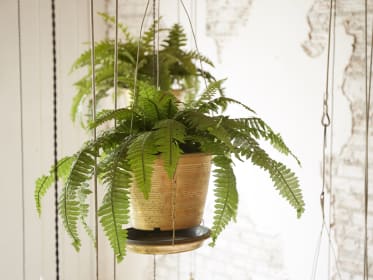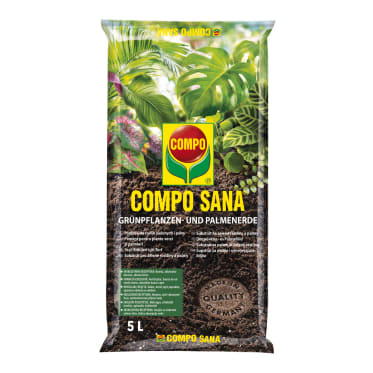Frequent search terms

- COMPO
- Guide
- Plant Care
- Indoor plants
- Hanging plants: How plants grow at lofty heights
Hanging plants: How plants grow at lofty heights
Hanging baskets, hanging plants, vertical flowerbeds and plant ladders: Many plants also grow well at lofty heights and not just when space becomes a little tight on the windowsill. But which plants can be positioned at lofty heights and what does this mean for their care? We give you an overview!

The perfect plant arrangement
Plastic, wood or ceramic pots are hung from the wall or ceiling for plants which have shoots that should dangle freely. The pots for hanging plants often have pre-mounted brackets or chains and are attached to the appropriate holders. The macramé method, in which a retaining net is tied around the flower pot, is also popular.
If you don't want to hang plants up directly, you can also place them on shelves, cabinets, boxes, stools and pillars. You can place or hang your plants at many different heights and create a lively jungle feel in your home.
Depending on the actual attachment method or the appearance of the plant, you should consider the individual location and care requirements of the desired plant. The following applies to hanging houseplants: Check beforehand whether the plant prefers sunlight or shade. Avoid very dark corners and don't place or hang pots too high so that daylight can actually reach the plants and you won't have insurmountable problems when watering your plants.
We also recommend that you take a closer look at the surface before choosing the location. There's always the possibility that water will drip out of the pot or dead leaves will fall down. Of course, a light carpet or sensitive parquet flooring is less suitable (at least without additional protection) than a wipeable tiled floor.
Make sure that the support structures are stable enough to carry the weight, including when the soil is wet. The plants should not hang too unevenly so that the top doesn't fall down straight away when it is touched. Watering should not cause the pot to overflow with water, either.

Suitable plants
Indoor plants with shoots that grow downwards are particularly suitable for being positioned vertically. The fern is a great example: It looks wonderful in a hanging plant pot on the side or up on a high shelf. But the benefits are not limited to its visual appearance: It is advantageous for the healthy development of such plants if there is enough space and the shoots don't touch the ground. For example, if a spider plant gets brown spots on the tip of its leaves despite proper care, it can be helpful not to leave it on the ground.
Other suitable hanging or climbing plants for your rooms are: Spider plant, Devil's ivy, Monstera, climbing fig, philodendron, maidenhair fern, waxplant, Ceropegia and treebine. Succulents, such as string-of-pearls/string-of-beads, mistletoe cactus types or the moonlight cactus, are other good options.

Optimal care for hanging plants
The soil
Fill the pots with a high-quality soil with a loose, airy structure and good water absorption capacity. A non-flowering plant and palm soil is a good option for this. COMPO's soils contain a starter dressing for up to eight weeks' nutrient supply. The root activator promotes a balanced distribution of nutrients in the plant pot. The root growth is significantly improved and it encourages the development of beautiful, decorative leaves.
Watering
Generally speaking, watering is no different from plants on windowsills, but it is often more difficult to carry out. In particular, this is because it is not easy to tell whether the soil is dry or moist. So, you should pay close attention: Many of the plants mentioned need a consistent water supply, but waterlogging in hanging plants should be avoided at all costs. Many pots are fully closed at the bottom so that no water drips out – there is no drip tray. This means that excess water can't flow out. So, check moisture levels regularly.
Leaf care
In particular, high-hanging plants also like to have their leaves dusted off regularly. You can use leaf care products for this that are also suitable for hard-leaved houseplants and make the leaves look perfect. Alternatively, in case of a lot of dust, it also helps to shower off plants: Carefully spray the plant for a few seconds from head to toe and allow it to drain well before hanging it up again.
Fertilisation
Hanging plants, like most potted plants, need sufficient nutrients from the limited amount available in the soil. Add a liquid fertiliser suitable for the plant to the irrigation water once a week between March and October. Supplying nutrients is even easier with a slow-release fertiliser: two doses of fertiliser during the season will do.
Suitable products for your hanging plants




